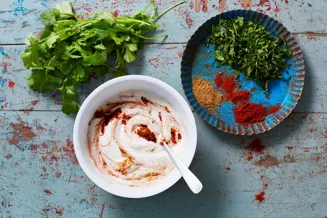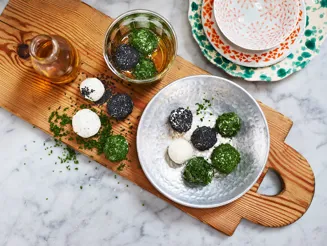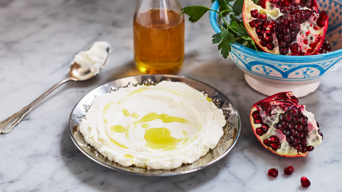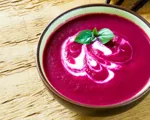
Labneh is a dairy product commonly found in Middle Eastern and Mediterranean cuisine. It is created by straining yogurt to remove the whey, resulting in a thick and creamy texture similar to cream cheese or Greek-style yogurt.
Labneh can be enjoyed in various ways, serving as a spread, dip, or condiment. It is often drizzled with olive oil and sprinkled with herbs like mint or thyme to enhance its flavour. The versatility of labneh allows you to incorporate it into both savoury and sweet dishes. It is often served alongside bread, pita, or crackers, used as a topping for salads or roasted vegetables, or incorporated into dips and sauces.
Labneh's creamy texture and tangy taste have made it a popular substitute for cream cheese or crème fraiche.
How to make labneh?
To make labneh, yogurt is typically mixed with salt and then placed in a cheesecloth to drain. The whey drips out over several hours or overnight, leaving behind a thickened yogurt with a tangy flavour.
Easy labneh recipe
To make labneh at home, begin by selecting your preferred yogurt, with Greek-style or whole milk options being preferable for optimal results. Add salt to the yogurt to enhance the flavour.
Line a strainer with a cheesecloth over a bowl. Pour the yogurt into the lined strainer, ensuring that the cloth covers it completely. Allow the yogurt to rest undisturbed in a cool place or the refrigerator. The longer it is strained, the thicker and more concentrated the consistency becomes. Strain it for 8-12 hours for a soft texture or leave it for 24 hours or longer for a thicker result.
Transfer the strained labneh into a container. If desired, you can season the labneh with herbs or spices. Store in the refrigerator.
Is labneh cheese or yogurt?
Labneh is technically a strained yogurt rather than a cheese. While the straining process gives it a texture similar to soft cheese or cream cheese, labneh is made by straining yogurt to remove the whey, resulting in a thicker consistency.
It retains the tangy flavour and some characteristics of yogurt, making it a popular dairy product in Middle Eastern and Mediterranean cuisines. Labneh is often referred to as "yogurt cheese" due to its resemblance to cheese in terms of texture and usage, but it is not a cheese made from curdling milk.
How to eat Labneh
Labneh is a versatile ingredient that can be enjoyed in various ways. It is a staple in Middle Eastern and Mediterranean cuisines and naturally complements falafel, kebabs, shawarma, grilled fish, and more. It is often used as a cooling accompaniment or a creamy element in those dishes.
It is also commonly included in mezze platters, where it is drizzled with olive oil and sprinkled with herbs like mint, thyme, or za'atar to enhance the flavour and presentation.
Other ways to enjoy labneh include using it as a creamy dressing or topping for salads. Its tangy flavour and velvety texture add a delightful twist to fresh greens or vegetables. It can be enjoyed on its own or paired with other dips like hummus, baba ghanoush, or tzatziki. Or try spreading it on sandwiches or wraps as a flavourful alternative to mayonnaise, providing a creamy element that complements most fillings.

Besides savoury dishes, labneh can be incorporated into sweet dishes. By sweetening it with honey, maple syrup, or a sprinkle of cinnamon, it can be used as a dip for fruits, a filling for pastries, or as a topping for desserts like pancakes or waffles. The tangy creaminess of labneh adds a unique and delicious dimension to these sweet treats.

There are many yogurt-like products that can be included in your cooking. Find inspiration in our articles What is kefir?, Can you cook with skyr?, and What is quark?.
Can you freeze labneh?
Yes, you can freeze labneh, but it may cause some changes in texture and consistency. It can become slightly grainy or watery upon thawing, but in most cases, a good stir will get it back on track.
To freeze it, make sure it is fresh and has not been frozen previously. Transfer it to an airtight container or freezer-safe bag to prevent air from entering and affecting the quality. Make sure to leave some space for expansion. Frozen labneh can be stored for about 2-3 months. When you want to use it, thaw it in the fridge overnight.
What does labneh taste like?
Labneh has a distinct and tangy flavour. It carries the characteristic taste of yogurt, although more concentrated and slightly more acidic due to its straining process. The tanginess can vary depending on the yogurt used and the duration of straining.
It has a creamy and smooth texture, similar to cream cheese or Greek-style yogurt, with a thickness that can range from spreadable to more firm and scoopable, depending on the duration of straining. It offers a pleasant richness and mild tartness, making it appealing to many palates.
How long does labneh last in the fridge?
When properly stored in the fridge, labneh can typically last for about 1 to 2 weeks. The exact shelf life varies depending on factors such as the freshness of the yogurt used, the straining process, and the overall quality of the labneh. To maximise its shelf life, store it in an airtight container to maintain freshness and prevent air exposure.
Can you make labneh with Greek-style yogurt or skyr?
Yes, labneh can be made with Greek-style yogurt, which is known for its thick and creamy texture. The process is similar to making it with regular yogurt. Simply salt and strain the Greek-style yogurt in a cloth-lined strainer and refrigerate it to achieve the desired thickness.
You can also make labneh using skyr, although the final result may differ slightly in texture and taste due to the thicker texture and milder flavour of skyr.
What is the difference between labneh and yogurt?
The main difference between labneh and yogurt lies in their texture and consistency. Yogurt is a fermented dairy product made by introducing specific bacterial cultures to milk. The bacteria convert lactose (milk sugar) into lactic acid, giving yogurt its tangy flavour. The end product is a smooth, creamy, and pourable or spoonable consistency.
Labneh, on the other hand, starts with yogurt as its base. It is made by straining the yogurt to remove the whey, resulting in a thicker, more concentrated product. The straining process allows the liquid whey to separate from the solid components of the yogurt, leaving behind a texture similar to that of soft cheese or cream cheese, although it retains the tangy flavour of yogurt.





































&format=webp)







